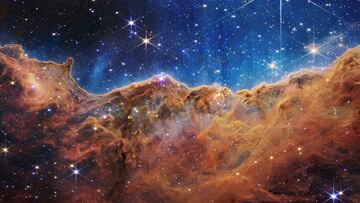What to know about NASA’s James Webb Space Telescope
New technology has allowed scientists to study distant galaxies and planets in greater detail, in the hope of unlocking some of the secrets of the universe.


On Monday, 11 July 2022 President Joe Biden, standing alongside Vice President Kamala Harris and NASA Administrator Bill Nelson, unveiled the first images from the agency’s ground-breaking James Webb Space Telescope.
One day later the full collection of the first science images were released during a live event, showing the Cosmic Cliffs in the Carina Nebula, Stephan’s Quintet, and the astonishing Southern Ring Nebula.
“You know what I’m most excited about?” said Thomas Zurbuchen, NASA’s associate administrator for science, during the event. “There’s tens of thousands of scientists — and frankly, some of them just got born or are not even born — who are benefiting from this amazing telescope because it will be with us for decades.”
What technology is on board the James Webb Space Telescope?
The James Webb telescope made history as the largest and most powerful space science telescope ever constructed, overcoming huge technical challenges to produce the striking images. The incredible clarity of the images is a result of a massive primary mirror, comprised of 18 gold-plated hexagonal sections, which measures 21.3 feet across.
It is fitted with a huge five-layer deployable sunshield, the size of a tennis court, to allow it to function in the most inhospitable conditions. This is vital as the telescope is currently orbiting the sun and roughly one million miles from earth.
Just Released
— Neil deGrasse Tyson (@neiltyson) July 12, 2022
Deepest-ever view of the cosmos from @NASAWebb. The spiked objects are local stars in our own Galaxy. ignore them. Everything else is an entire galaxy. Many distort into arcs, revealing spacetime curvature from the gravity of a galaxy cluster in the image's center. pic.twitter.com/s1XaOLegae
The telescope is fitted with a Near-Infrared Camera (NIRCam); Near-Infrared Spectrograph (NIRSpec); Mid-Infrared Instrument (MIRI); and a Near-Infrared Imager and Slitless Spectrograph (NIRISS) with Fine Guidance Sensor (FGS). All this allows scientists back on earth to conduct a wide range of observations and hopefully illuminate some of the great mysteries of the universe.
What are the targets of the James Webb Space Telescope?
The enormous telescope is the result of a huge global collaboration between NASA, the European Space Agency (ASA) and the Canadian Space Agency, alongside many other international partners. Hundreds of scientists and thousands of engineers have worked together to make it a possibility, but what is the purpose of the James Webb Space Telescope?
First light and rionization – The telescope will study remnants from the ‘epoch of reionization,’ which is the period immediately after the very first stars were formed. It takes its name from the process which saw the neutral hydrogen reionized by the radiation from those first stars.
Assembly of galaxies – The formation of galaxies gives insight into how matter is arranged in our universe, which could help scientists understand how the universe has evolved.
Related stories
Birth of star and protoplanetary systems – Stars are first formed from huge gas clouds but scientists have not been able to study the actual process inside the gas. The James Webb has an infrared sensor which will study the sources of heat, pinpointing where stars are being forged.
Planets and the origins of life – Recent technological developments have allowed scientists to discover a huge number of exoplanets, but they have struggled to study them in greater detail. The James Webb Space Telescope will allow them to image the atmospheres on the planets and even judge whether distant planets could be habitable for life.

